#there’s a brutality and a raw humanity to it that puts the odyssey at a lower priority to me) but im so freaking excited to read her iliad
Text
emily wilson out here translating the iliad and i am once again wishing i knew how to read and translate ancient greek
#listen where there’s a will there’s a way but i just finished my degree audit and looks like i will only be able to manage a classics minor#with latin emphasis (unless i abandon latin for greek which i’m not going to do even though it pains me)#but i really want to make my own iliad someday….#at this rate i’ll only ever end up making a queer prose adaptation and be criticized for projecting modern notions of sexuality onto a#completely different set of values and social understandings of homosexuality….#(which. if anything there should be more gay people in the song of achilles. don’t be mean to me i promise i understand ancients)#anyway i might just have to make a book of poetry or a novel adaptation or whatever whatever but what if i want to learn the script#and painstakingly translate every single word through years and years of dedication. while also being a librarian as my main thing#shdhdhdf i’m never gonna be classics scholar enough to professionally translate. and if i were it would be latin. but i can dream….#anyway i’m no longer failing my french class (have a 70% that should only be going up) but i’m still failing historical linguistics#my latin grade is great i’m acing it but my library science class is a D (which should be fixed in two days though — just needs more data)#so i am giving myself permission to sleep early tonight and go into class well rested for once. i’m not feeling well but that’s a constant#anyways if anyone reads the wilson iliad let me know!! i’m a fake fan of her work and haven’t read her odyssey (something about the iliad….#there’s a brutality and a raw humanity to it that puts the odyssey at a lower priority to me) but im so freaking excited to read her iliad#i have to prioritize schoolwork but soon. i’ll have to ask my latin teacher about it tomorrow though she’s an iliad enjoyer#anyway good news i think i’ll be able to get a history major with certificates in digital studies and classical studies (the two genders….)#and graduate comfortably in four years with honors in the major. this is ignoring how i’m failing my classes. i promise i won’t be forever#anyways the point is: wilson’s iliad — i will read it as soon as possible and i’m very excited#also i checked out a book from the library called the lexicographers dilemma: the evolution of proper english from shakespeare to south park#but i haven’t had the chance to read it and soon it will be due…. college is evil i’m too busy learning things to learn other things!!!!#anyway if i do honors in the major then i’m excited to eventually earn credit from a capstone thesis which i would do on lexicography#throughout history with an emphasis on classification systems and basically peter mark roget#ok anyway. wandering all over the place but the point is. wilson’s iliad. very exciting. can’t wait to find the time#and eventually i will write an iliad adaptation of my own i will. just not a full translation shdhdf that’s an unrealistic goal#especially when again. my capstone project is going to be about taxonomy of ideas. ancient epics are secondary….#anyway i hope everybody is doing well!! i am going to bed soon-ish but other than that i am around so lmk if you need anything#me. my post. mine.#college talk#delete later
5 notes
·
View notes
Text
How Covid-19 Will Massively Boost Innovation

Both ancient history and modern times abound with examples of striking, innovative ideas that emerge when people’s customary behaviour is severely constrained
The emergence of Covid-19 resulted in an almost unprecedented impact on the people of the world. The list of human activities that has been curtailed is a very long one, compelling responses ranging from outright cessation to avoidance to practical compromise. Whatever the impact, change has been enforced on much of how we live, on how we get things done.
A natural human reaction is that this cannot possibly be a good thing. It’s like having one arm tied behind your back. Complete freedom to utilize all of our faculties, without constraint, is self-evidently the sure path to progress is it not? If you need a good, practical idea for something, the common worldview is to throw off all shackles and allow your thinking the freedom to roam anywhere. This is widely assumed to be the most productive way to think innovatively.
Well, history begs to differ. Contrary to what we might think, innovative thinking is also unleashed when you deliberately limit your choices rather than opening up your mind to endless possibilities.
Sink The Boats
General Xiang Yu, who lived in China from 232BC to 202BC, was a brutal warlord whose victories in many battles won him power over large tracts of China. His penchant for constraining his thinking was no more evident than in the Battle of Julu (209BC) when he took on the Qin Dynasty. Being significantly out-numbered, victory was far from certain for Xiang Yu and his army. He required his troops to do whatever it took to win.
However, he did not conduct a brainstorming session to exhaust his military options. After crossing the Yangtze River, while his troops slept, Xiang Yu ordered their boats sunk. The next day he told his men that their choice was to fight to win quickly against overwhelming odds, or die without hope of escape. In the face of that immoveable constraint, Xiang Yu’s army won the battle.
What was going on here?
Unshackled Versus Shackled Thinking
While no one knows precisely how the brain formulates fresh, novel ideas – especially ones that have valuable application – there are many techniques that claim to provide the necessary stimulation so that the brain can do its mysterious work. One of the best-known and widely practiced techniques is brainstorming, where a group of people work together to “brainstorm” lots of spontaneous ideas in an attempt to find a solution for a specific problem.
There are many other methods, systems, checklists and frameworks in use. However, almost without exception, they have the same fundamental end in common: they seek to stimulate the brain to “think outside the box” – unleashing it, some would say – by encouraging thinking that is unconstrained and unstructured.
Without getting too technical, it is useful to regard their practice as a type of Divergent Thinking. The psychologist Joy Paul Guilford first coined this term in 1956. It describes the thought process or method used to generate creative ideas by pursuing many possible solutions. However, Guilford, almost inevitably, also identified an opposite approach to divergent thinking which he described as Convergent Thinking. Convergent thinking follows a process to zero in on just one workable solution. Much conventional teaching and learning occurs in a convergent thinking environment.
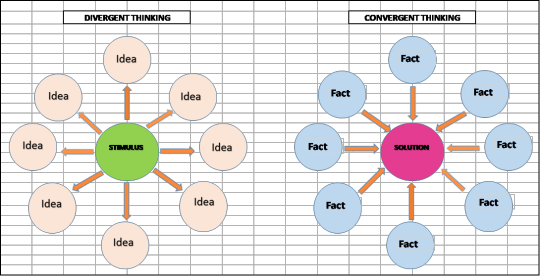
A typical representation of the distinction between divergent thinking and convergent thinking
For the sake of simplicity, let us refer to all divergent-type thinking as Unshackled Thinking and convergent-type thinking (which we are going to talk about now) as Shackled Thinking.
Sink The Boats Again ...
In 1519, the Spanish conquistador Hernan Cortes used a similar trick to that of General Xiang Yu. He led the first expedition that caused the fall of the Aztec empire. After he and his men landed on the East Coast of Mexico, he sank his own ships. Although his men longed to return home, with all their options for doing that eliminated, they quickly re-focused on helping Cortes achieve his expeditionary goal.
Examples of such shackled thinking abound in more genteel pursuits as well.
In The Social History of Art (1951), sociologist Arnold Hauser, in talking about the art of the early Renaissance, observed that an artwork did not normally originate in the creative urge, self-expression and spontaneous inspiration of the artist, but in the task set by the patron of the proposed creation. In addition to general direction, patrons specified the size of canvas, number and kind of figures, the amount of expensive pigment to be used, the weight of gold foil in the frame, and other details. Within those imposed boundaries, the artist was then free to exercise their creativity. Such constraints did not hinder the magnificence of what was produced during the Renaissance; they surely contributed to it.
Quilt designs from American Amish society, which are arguably the most unique and collectable in the world, are created in circumstances where constraint on what is acceptable decoration acts as a stimulus to creativity and to systematic development of the art form. The Amish quilt uses a basic geometric design that is symmetrically put together using fewer pieces and small, evenly spaced stitches. It has bold, saturated colours with the use of black only in the borders. These constraints boost creativity and result in some very striking designs.
Let’s turn to the economic sphere. In his book, Worldly Philosopher; The Odyssey of Albert O Hirschman, Jeremy Adelman records the economist Albert Hirschman’s observations on the Karnaphuli Paper Mills in Pakistan. These were built in 1953 to exploit the ubiquitous bamboo forests but unfortunately the forests soon died. Those involved found ways to bring bamboo from elsewhere using Pakistan’s many waterways. The constraints imposed by nature forced those involved to be innovative. In fact, ultimately, the more diversified raw material base made the paper mills more valuable than they were before.
What about today? Innovating within the liberty of constraint is now more prevalent than ever and nowhere is this more apparent than within the so-called “sharing economy”. A smartphone enables the connecting of sellers and buyers without the usual constraints. Uber has become the world’s largest car hire service but doesn’t own any cars, sidestepping the previously daunting capital constraint of vehicle ownership. Airbnb is now one of the largest accommodation providers in the world and has avoided owning the expensive real estate for its guests. And Facebook, the world’s largest media company, has dodged the need to own content.
So What?
So, what do the sketches above suggest to us? It is tempting to say not much. After all, it is not that difficult to cherry-pick a cluster of truncated, historical vignettes and force apparently authentic lessons from what are essentially quirks of days gone by. But although striking in their own way, in their essence the sketches do not reflect quirky behaviour at all. Innovating under the burden of imposed constraints is not spectacular, unusual or rare, either in the past or now. When did we last play Sudoku? If we did, we were consciously seeking a solution that constrained us to fill various grids and sub-grids so that each contained all of the digits from 1 to 9.
Or, when did we last read or watch a detective story? From Sherlock Holmes to Miss Marple, from Hercule Poirot to Harry Bosch, we accompany them as they unravel their cases by treating each clue they discover as a constraint. Ultimately, they solve their case in a way that satisfies all of the constraints they ferret out.
Whether playing Sudoku or vicariously playing detective, we willingly accept necessary constraints in the pursuit of a satisfying goal. The constraints are part of the pursuit and part of the excitement. But we probably never explicitly think of them as constraints.
Which brings us back to Covid-19. Its pervasive constraints on the way we live are not of course something we welcome. But at the same time, those constraints will not be wholly fruitless. Although counter-intuitive, whether intentional or not, limiting our thinking to address some challenge we face can often be more effective than exposing that thinking to endless possibilities.
So, with a more accommodating mindset, what are the specific lessons we can draw from what Xiang Hu, Cortes and company did earlier?
It is possible to conceive of three things that many, many people will do as a result of Covid-19:
(i) When confronted with a task, they will re-frame their goal to deliberately exclude the options for its fulfilment that have been side-lined as a result of Covid-19;
(ii) Freed of a number of such distractions, they will confine their focus to developing only those solutions that are compatible with their re-framed goal; and
(iii) They will find a solution that satisfies achievement of their re-framed goal in spite of (and sometimes because of) the constraints that they are now prepared to live with.
The ramifications of Covid-19 -- how it plays out in the months and years ahead -- are immense, almost certainly incalculable. But it won’t all be bad. New ways of being, new ways of doing that would never have been contemplated under old paradigms, will be explored, refined and found to be better. Many will become the new norm once Covid-19 has passed. This will occur millions of times in every conceivable type of circumstance. There will be an explosion of innovative activity.
So, let’s not simply bemoan the loss of the freedom we have become used to because of Covid-19. Instead, let’s also seize the opportunity to innovate within the liberty of constraint.
0 notes
Text
My 10 Favourite Games Of 2017
This list was originally posted on the forum Resetera, but I felt like putting it up here too, with a little more insight into why I liked these games so much, and so they don’t get lost in the muddle of forum posts. Enjoy!
10. Snake Pass (Sumo Digital; Nintendo Switch, PS4, Xbox One, PC)
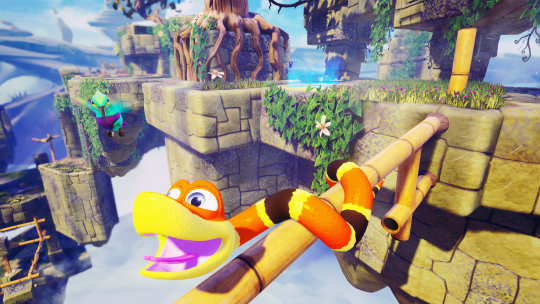
Sumo Digital has been a developer I've admired for years, particularly for their work on the Nintendo-tier kart racer Sonic & All-Stars Racing Transformed. Snake Pass is their first independently-produced title, and it has a great hook - the player controls a snake in much the same manner as a real snake might move. There's no jump button, no Earthworm Jim spacesuit, just the power to raise one's head and the strength to grip tightly to any object you've coiled around. There's no timer or enemies; Snake Pass is content to let you explore its levels at your own pace, letting you getting used to its unique feeling and take in the calming David Wise soundtrack. It's a game that feels like learning to ride a bike again, and the progression in ability over time is such a pleasing sensation that it earns it its place on this list by itself. The good use of collectables and generous helping of levels is icing on the cake.
9. Wolfenstein 2: The New Colossus (MachineGames; PS4, Xbox One, PC)
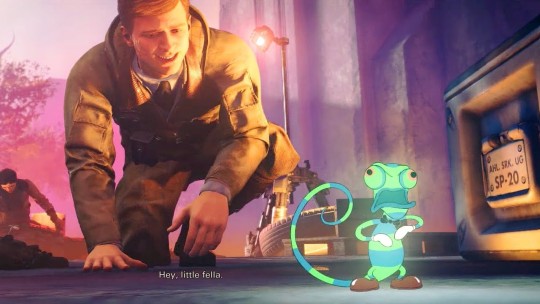
B.J. Blazkowicz returns and he's lost all meaning of subtlety whilst he's been out of action. Wolfenstein 2 shoots all of its shots - the action is bloody, explosive carnage, and the subject matter isn't satisfied with just skewering Nazi idiocy and narcissism, taking time to shine a light on White America's love affair with sitting back and reaping the rewards of compliance under fascist rule. Whether it's exploring B.J.'s broken psyche, giving Wyatt a crash course on hallucinogenics or putting you under the spotlight in a terrifying audition, MachineGames refuse to pull their punches, each great moment coming swinging like B.J.'s Nazi-reprimanding fireaxe. The combat encounters are far from polished, with stealth being heavily nerfed from The New Order and the half-way shift in tone from borderline-satirical diatribe on mortality and American race relations to comic-book capers is incredibly stodgy, but Wolfenstein 2 leaves a hell of an impression all the same. Shame about that credits music.
8. Gorogoa (Jason Roberts; PC, iOS, Nintendo Switch)
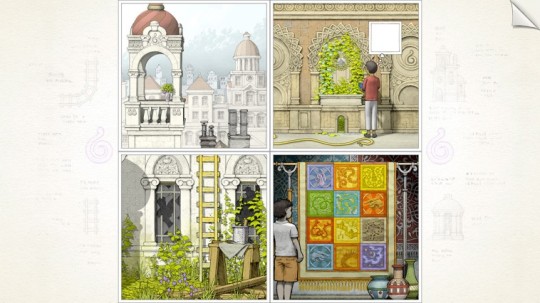
A good puzzle game can make a really strong impression, guiding you subtly by the hand to make you feel like a member of MENSA just for pressing a few buttons or prodding at a screen. With Gorogoa, I can't even begin to describe how the puzzles actually work. Imagine a window segmented with 4 panes of glass, and now imagine you can drag elements out of those panes and into other panes, or over where there isn't a pane to create a new pane... See, it’s hard! In as simple terms as I can muster, it’s a game about taking the world apart and putting it back together again to create paths and progress for your anonymous young hero. It’s intensely abstract, yet the South Asian aesthetic feels like a living locale, an exploration of a boy's days-to-come. It's a short experience, but with each puzzle solved making me feeling smarter than Albert god damn Einstein, it's one that will stick with me for a long time.
7. Splatoon 2 (Nintendo EPD; Nintendo Switch)
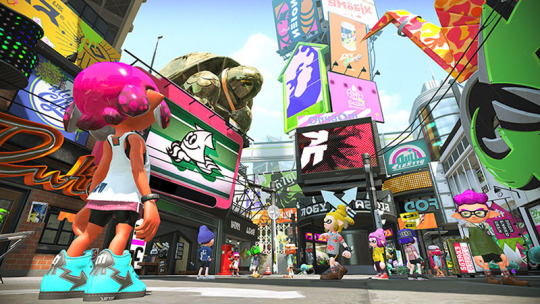
Like pretty much everyone, I didn't own a Wii U, but the sting of that decision never really happened until the arrival of Splatoon - Nintendo's first proper new "core" universe since what felt like Pikmin. It instantly looked like sheer fun - and as a big fan of both Jet Set Radio and The World Ends With You, it was clear as day Nintendo's younger designers were picking up the Shibuya fashion torch those games dropped behind them. Put simply, it's totally my shit. Splatoon 2 confirms my suspicions and then some, being the first multiplayer title I've enjoyed online in forever. I can't get enough of the soundtrack, the sound effects, the amazingly catty banter between Pearl and Marina, and just the feeling of dropping into ink, strafing around a sucker and blasting them straight between the eyeballs with my N-ZAP '85. 20% of Switch owners in the US can't be wrong.
6. Yakuza 0 (SEGA; PS4)
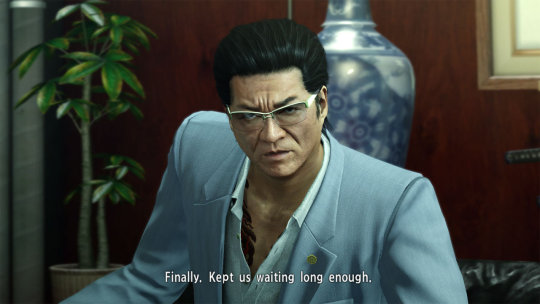
The only games I've played previously by SEGA's Toshihiro Nagoshi are the brilliant arcade/Gamecube bangers F-Zero GX and Super Monkey Ball 2, plus his one-off PS3 sci-fi shooter Binary Domain. Loving those 3 wacky games, I always felt a little put-off by his regular gig nowadays being a series about Japan's most decorated crime organisation, and a bare-knuckle brawler at that. Yakuza 0, the 80s-set series prequel that serves as a perfect entry point for series newcomers, proved my suspicions ill-founded. It's a game which instantly casts the majority of the yakuza as control freaks and bullies, pits its protagonists Kiryu and Majima as their unfounded targets and pawns... and then lets you fight your way out of hell via brutal finishing moves, bizarrely complex business management sidequests and, if you're so inclined, a gun shaped like a giant fish. It's that kind of game that always keeps you guessing whether or not you should take it seriously, and so it wins you over with its best-in-class action choreography, astonishingly good direction and a never-ending deluge of sidequests, minigames and challenges. Don't sleep on Kamurocho.
5. Sonic Mania (SEGA/Christian Whitehead/Headcannon/PagodaWest Games; Nintendo Switch, PS4, Xbox One, PC)

If you’re reading this, you probably know I'm a Sonic apologist. I don't really stand by the 3D entries - bar Sonic Generations, which I genuinely love - but the narrative that "Sonic was never good" is some ridiculous meme that I can't stand. They were genuinely fun games, albeit far from perfect; every game can use some improvement. Sonic Mania is that improvement, spinning the level themes and gimmicks from the original Mega Drive (and Mega CD) games into vast new forms, with myraid routes, tons of secrets, an astonishing sense of speed from beginning to end and fairer, more agreeable, more exciting level design. Old locales, new levels - oh, and some new locales as well, one of which (Studiopolis Zone) is an instant classic. 16:9 presentation, all new animations and crazy levels of animation detail, and a mind-blowing soundtrack by Tee Lopes - Sonic Mania is the perfect Sonic game.
4. NieR: Automata (Square Enix/PlatinumGames; PS4, PC)
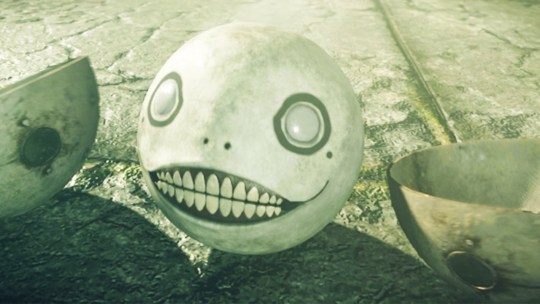
For my first foray into the sunken mind of Yoko Taro, he couldn't have left a better impression. NieR: Automata uses Platinum's engaging-at-worst, thrilling-at-best melee combat as the language to tell his new story of how pointless it is for anyone to even bother throwing themselves after ideals of society or humanity, and why it's worth trying all the same. Every inch of this game feels crusted in Taro’s sensibilities, with the no-bullshit 2B and her curious whiny partner 9S running into robots waving white flags, avenging fallen comrades, establishing monarchies, throwing themselves to their deaths, and coming to terms with their crumbling existence in apocalypse. It's crushing, it's raw, it's often dull, but its uniquely bleak vision of AIs breaking free of their programming has a grip as powerful as a Terminator's. And when it’s ready to let you go, it has you send it off with the most memorable credits sequence in history. Glory to Yoko Taro, glory to PlatinumGames - glory to mankind.
3. The Legend of Zelda: Breath of the Wild (Nintendo EPD; Nintendo Switch, Wii U)

Standing in the centre of a bridge connecting Hyrule’s broad, emerald green fields to the desert mountain approach, a bridge overlooking the still Lake Hylia, I fire an arrow into a lizard bastard’s head, or at least I try to. He dodges it and rushes me, forcing me to jump away and retaliate with my claymore. Out for the count, I resume looking for the lost Zora wife I’ve been asked to seek out, who apparently washed all the way downstream in a recent downpour. I can’t see any wife - my entire view is dominated by the giant green dragon snaking across the night sky above me. The wind picks up, but I am too awestruck by its presence to take note that I could glide up to it and shoot off a valuable scale. Instead, I just stand and stare, this utterly unexpected moment happening before my eyes. Friend or foe? A boss monster, perhaps? A vital story element later on? The answer ended up being none of the above: in The Legend of Zelda: Breath of the Wild, there be dragons, and that fact in and of itself speaks volumes about what this game is about. After 30 years, Hyrule finally feels alive.
2. Night in the Woods (Infinite Fall; PS4, Xbox One, PC, Mac, Linux, Android, iOS)
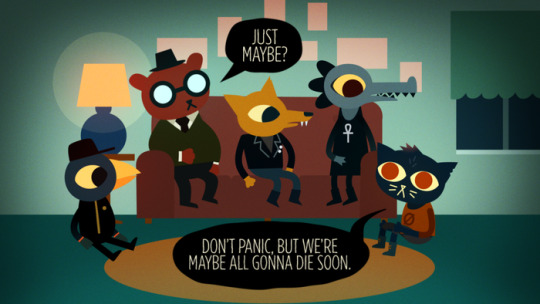
Very few games instil a genuine emotional response within me, but the story of Mae Borowski's no-fanfare return from college to suburban gloom resonates hard with me. It's an expert at the little touches - the needless-yet-fun triple jump, the not-so-starcrossed rooftop musicians, the impulsive reaction to poke a severed arm with a stick - and woefully precise with its big swings, like an upsetting cross-town party, a wave of violent frustration amongst the townspeople, and the inability to just lay it all on the table with friends and family when you need to most. In the cosmic dreams of shitty teens, Night in the Woods finds an ugly beauty in depression.
1. Super Mario Odyssey (Nintendo EPD; Nintendo Switch)

It’s impossible to deny 2017 has been the year of Nintendo. There’s plenty of celebrate elsewhere, but the Switch’s rise to prominence as the machine to be playing ideally everything on, and the amount of absolute smash hits Nintendo has producing this year makes it hard for the narrative to focus elsewhere. The epitome of all this is their final killer game of 2017: Super Mario Odyssey, the grand return of a more open-ended style of Mario platformer. A true blue achievement in joyous freedom, it brings together everything from Mario's history of 3D platforming - 64's freedom, Sunshine's other-worldliness and sky-high skill ceiling, Galaxy's spectacle, 3D World's razor-sharp platforming challenge - and throws into one big pot, creating a Mario where both the journey and the destination are one and the same, and exciting to the very end. In a year of amazing games that hit upon horrid, upsetting themes with delicate, pinpoint accuracy for tremendous success, I’m not sure whether it’s a shame or an inevitability that such an unapologetically surprising, happy game made the biggest mark on me this year, but either way, I’m welcome to have Mario be truly Super once more.
#goty#2017#splatoon2#super mario odyssey#zelda breath of the wild#yakuza 0#night in the woods#snake pass#sonic mania#gorogoa#wolfenstein#nier automata
6 notes
·
View notes